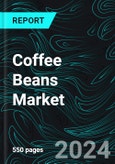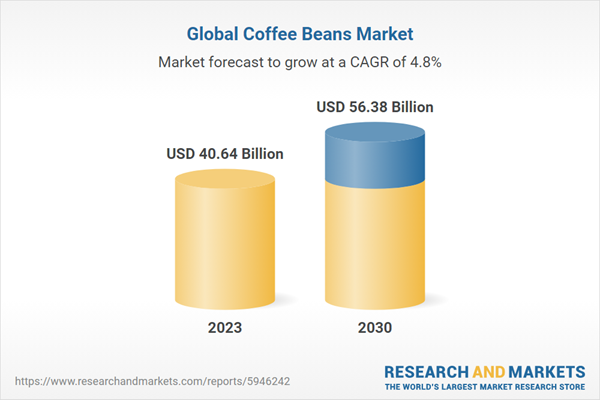Coffee Beans Market is anticipated to grow at a CAGR of 4.79% from 2024 to 2030
Increased intake of coffee and coffee beverages, pushed through its popularity by the diverse younger population and café subculture, is propelling the worldwide coffee beans market. Coffee, one of the most widely consumed drinks internationally, is especially favored by millennials, with data from the British Coffee Association indicating that approximately ninety-eight million cups are consumed daily in the UK. Ground coffee and single-serve coffee pods are increasingly desired, especially amongst millennials aged 16 to 34, representing 16% of all buyers. Moreover, the café lifestyle flourishes, with 80% of coffee shop visitors frequenting at least once a week, while 16% visit daily, further fueling the need for coffee merchandise.Further, coffee beanss contribute to the prevention of chronic illnesses, including certain types of diabetes, skin cancer, and coronary heart sicknesses, while also improving the immune system, thereby bolstering the coffee beans market. An evaluation by the Harvard T.H. Chan School of Public Health suggests that ingesting low to mild doses of caffeine (50-300 mg) can enhance alertness, strength levels, and attention. A study concerning 37,514 women revealed that slight coffee consumption of 2-3 cups consistently per day was connected to a 21% reduced risk of a heart ailment. Furthermore, a meta-evaluation of 21 prospective research inspecting coffee consumption and mortality from chronic illnesses demonstrated a correlation between mild coffee intake (3 cups each day) and a 21% decrease in the threat of cardiovascular disease-related deaths than non-drinkers.
Moreover, the burgeoning popularity of coffee beanss in cosmetics drives the global coffee beans market forward. While historically consumed as a beverage, coffee is increasingly considered a viable skin care solution. This surge in recognition is attributed to the presence of phenolic compounds, like chlorogenic acids and caffeine. Caffeine is used in cosmetic formulations for its photoprotective, anti-aging, cellulite-decreasing, and hair-regrowth properties. For instance, in 2023, Luster Cosmetics, renowned for its premium beauty services, added a new coffee-infused line. This modern range consists of the herbal benefits of coffee beanss in various merchandise, promising an exclusive and powerful beauty regimen. So, the Coffee Beans Market was valued at US$ 40.64 Billion in 2023.
Technological coffee processing and manufacturing developments are also propelling the coffee beans market. According to coffeeresearch.Org, while numerous unique coffee species exist, two major ones are cultivated these days. Coffeaarabica, referred to as Arabica coffee, accounts for 75-80 percent of the world's production. Coffeacanephora, known as Robusta coffee, bills for approximately 20 percent and differs from Arabica coffees in terms of flavor. Technological developments enhance the quality and uniformity of coffee beanss in harvesting, milling, and roasting processes, stimulating market enlargement and increasing product alternatives.
Also, introducing new flavors, packaging, and advertising campaigns through diverse channels, including social media, is anticipated to boost international coffee beans market growth. For example, in 2023, Krispy Kreme multiplied its beverage menu across participating U.S. shops, supplying iced, frozen, and hot coffees with smoother blends and more decadent roasts. Besides, the addition of oat milk gives customers more customization alternatives. Krispy Kreme offers a free doughnut by shopping for any new coffee or coffee beverage in-store, via drive-thru, or online. This initiative is part of a comprehensive beverage program relaunch, incorporating upgraded equipment and standardized training for consistent drink quality.
Key Players
The coffee beans market enterprises include Starbucks, Nescafe, The Kraft Heinz Company, Lunchin Coffee, J M Smucker, Coca-Cola, Dutch Bros, Keurig Dr Pepper, and JDE Peet's N.V.In April 2023 - Nescafe launched “Ice Roast” coffee, a new product catering to the growing trend of in-home café style cold coffee consumption, especially among Generation Z. People with cold water or milk can consume the product.
Consuming Countries - Coffee Beans Consumption Market of 11 Countries covered in the Report:
1. European Union2. United States
3. Brazil
4. Philippines
5. Japan
6. Canada
7. China
8. Indonesia
9. Russia
10. United Kingdom
11. Other
Production Countries - Coffee Beans Production Market of Arabica & Robusta in 11 Countries covered in the Report:
A. Arabica
1. Brazil2. Colombia
3. Ethiopia
4. Honduras
5. Peru
6. Guatemala
7. Mexico
8. Nicaragua
9. China
10. Costa Rica
11. Others
B. Robusta
1. Vietnam2. Brazil
3. Indonesia
4. Uganda
5. India
6. Malaysia
7. Cote d'Ivoire
8. Thailand
9. Mexico
10. Tanzania
11. Other
Importing Countries - Coffee Beans Import Market of Roast and Ground and Soluble in 11 Countries covered in the Report:
A. Bean Imports
1. European Union2. United States
3. Japan
4. Russia
5. Switzerland
6. South Korea
7. Canada
8. United Kingdom
9. Algeria
10. Colombia
11. Others
B. Roast and Ground Imports
1. United Kingdom2. United States
3. Canada
4. Ukraine
5. South Korea
6. Russia
7. China
8. Australia
9. Saudi Arabia
10. Vietnam
11. Others
C. Soluble Imports
1. Philippines2. Canada
3. China
4. United States
5. Indonesia
6. Japan
7. South Africa
8. Russia
9. Ukraine
10. Argentina
11. Others
Exporting Countries - Coffee Beans Export Market of 11 Countries covered in the report:
A. Bean Exports
1. Brazil2. Vietnam
3. Colombia
4. Indonesia
5. Uganda
6. Honduras
7. Ethiopia
8. India
9. Peru
10. Guatemala
11. Others
B. Roast and Ground Exports
1. European Union2. Switzerland
3. Vietnam
4. Colombia
5. Mexico
6. China
7. Indonesia
8. Brazil
9. Panama
10. Costa Rica
11. Others
C. Soluble Exports
1. Brazil2. Malaysia
3. Vietnam
4. India
5. European Union
6. Indonesia
7. Mexico
8. Colombia
9. Thailand
10. Ecuador
11. Others
All the Key players have been covered from 3 Viewpoints:
- Overview
- Recent Development
- Revenue Analysis
Company Analysis:
1. Starbucks2. Nescafe
3. The Kraft Heinz Company
4. Lunchin Coffee
5. J M Smucker
6. Coca cola
7. Dutch Bros
8. Keurig Dr Pepper
9. JDE PEET'S N.V.
Table of Contents
Companies Mentioned
- Starbucks
- Nescafe
- The Kraft Heinz Company
- Lunchin Coffee
- J M Smucker
- Coca cola
- Dutch Bros
- Keurig Dr Pepper
- JDE PEET'S N.V.
Methodology
In this report, for analyzing the future trends for the studied market during the forecast period, the publisher has incorporated rigorous statistical and econometric methods, further scrutinized by secondary, primary sources and by in-house experts, supported through their extensive data intelligence repository. The market is studied holistically from both demand and supply-side perspectives. This is carried out to analyze both end-user and producer behavior patterns, in the review period, which affects price, demand and consumption trends. As the study demands to analyze the long-term nature of the market, the identification of factors influencing the market is based on the fundamentality of the study market.
Through secondary and primary researches, which largely include interviews with industry participants, reliable statistics, and regional intelligence, are identified and are transformed to quantitative data through data extraction, and further applied for inferential purposes. The publisher's in-house industry experts play an instrumental role in designing analytic tools and models, tailored to the requirements of a particular industry segment. These analytical tools and models sanitize the data & statistics and enhance the accuracy of their recommendations and advice.
Primary Research
The primary purpose of this phase is to extract qualitative information regarding the market from the key industry leaders. The primary research efforts include reaching out to participants through mail, tele-conversations, referrals, professional networks, and face-to-face interactions. The publisher also established professional corporate relations with various companies that allow us greater flexibility for reaching out to industry participants and commentators for interviews and discussions, fulfilling the following functions:
- Validates and improves the data quality and strengthens research proceeds
- Further develop the analyst team’s market understanding and expertise
- Supplies authentic information about market size, share, growth, and forecast
The researcher's primary research interview and discussion panels are typically composed of the most experienced industry members. These participants include, however, are not limited to:
- Chief executives and VPs of leading corporations specific to the industry
- Product and sales managers or country heads; channel partners and top level distributors; banking, investment, and valuation experts
- Key opinion leaders (KOLs)
Secondary Research
The publisher refers to a broad array of industry sources for their secondary research, which typically includes, however, is not limited to:
- Company SEC filings, annual reports, company websites, broker & financial reports, and investor presentations for competitive scenario and shape of the industry
- Patent and regulatory databases for understanding of technical & legal developments
- Scientific and technical writings for product information and related preemptions
- Regional government and statistical databases for macro analysis
- Authentic new articles, webcasts, and other related releases for market evaluation
- Internal and external proprietary databases, key market indicators, and relevant press releases for market estimates and forecasts

LOADING...
Table Information
| Report Attribute | Details |
|---|---|
| No. of Pages | 550 |
| Published | March 2024 |
| Forecast Period | 2023 - 2030 |
| Estimated Market Value ( USD | $ 40.64 Billion |
| Forecasted Market Value ( USD | $ 56.38 Billion |
| Compound Annual Growth Rate | 4.7% |
| Regions Covered | Global |
| No. of Companies Mentioned | 9 |









